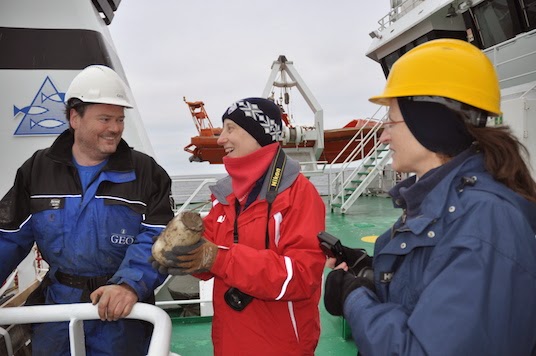Imagine to be on the stage of a sci-fi
movie, or of a documentary with David Attenborough: this was what I was feeling
like when I witnessed the deployment of the Calypso corer into a nearly 1,5 km
deep sea South-West of Spitsbergen.
A corer is a device for sampling sediments
into the seafloor. It comes in many different types and sizes, but the giant of
the family is absolutely the Calypso corer, and yesterday afternoon the
technicians of G.O. Sars were deploying one of this giant just in front of me.
 |
| Calypso corer outboard (Image: G. Realdon) |
 |
| The barrel linked with the weight (32 tons) (Image: G. Realdon) |
The Calypso on board the G.O. Sars is more than 20 m long and is normally lying on the deck of the ship alongside the starboard. Before the deployment, a mechanism transfers the tube outboard where it is connected with the weight and with a Kevlar cable, then turned vertical and launched into the sea.
Do you remember the imaging of the seafloor
described in the previous post? It was made specifically to find the right
location for the cast of the corer. One cannot make mistakes, the corer is
difficult to operate… and very expensive too!
Anyway a bit of luck is necessary, and yesterday the team of engineers, technicians and geologists had their share of luck. The sea was calm, all the operations ran smoothly and the corer returned on the deck.
 |
| Calypso is deployed into the sea. The oblique bar on the left is part of the trigger (Image: G.Realdon) |
 |
| Calypso is being recovered (Image: G. Realdon) |
And then, what about the core?
We were all hopeful and some of the experts
were making guesses about its length, but the verdict came when the core – with
its plastic liner - was extracted from the barrel and cut into sections about 1
m long.
The core sections, carefully sealed and
labeled with the identifying data, begun to accumulate on a shelf… and
continued to add beyond expectation!
Finally the recovered core was
outstandingly good and long: I could see the satisfaction in the eyes of
geologists and technicians. Everybody in the deck was smiling, joking and
cheering.
It was really a great emotion to witness
this event!
Immaginate di essere sul set di un film di
fantascienza, oppure di un documentario di David Attenborough: questo è ciò che
ho provato quando ho assistito alla calata del carotiere Calypso nel mare,
profondo circa 1,5 km, a Sud-Est di Spitsbergen.
Il carotiere è un dispositivo per
raccogliere sedimenti dal fondo marino. Ne esistono di diversi tipi e misure,
ma il gigante della famiglia è senz’altro il carotiere Calypso, e ieri
pomeriggio i tecnici della G.O. Sars
stavano calando uno di questi giganti proprio davanti ai miei occhi.
Calypso è un carotiere a pistone, cioè un
lungo tubo di acciaio (il barrel) con un peso di qualche tonnellata attaccato sopra
ed un pistone scorrevole dentro.
Quando il carotiere è vicino al fondale, un
grilletto (trigger) fa sì che il tubo sia spinto dentro i sedimenti dal suo
stesso peso e che il pistone risalga,
agevolando la discesa del barrel.
Il Calypso a bordo della G.O. Sars è lungo
oltre 20 m e normalmante sta disteso lungo il ponte della nave vicino alla
murata di sinistra. Prima della calata a mare un meccanismo trasferisce il
barrel fuori bordo, dove viene fissato al peso e a un cavo di Kevlar, poi il
tutto viene ruotato in posizione verticale
e calato in mare.
Vi ricordate l’imaging del fondo marino che
ho raccontato nel post precedente? Era stato fatto appositamente per trovare la
giusta posizione per la calata del carotiere. Non si possono fare errori e il
carotiere è difficile da movimentare… e anche molto costoso!
In ogni caso ci vuole anche un po’ di
fortuna, e ieri pomeriggio la squadra di ingegneri, tecnici e geologi ne ha
avuta abbastanza. Il mare era calmo, tutto è andato liscio ed il carotiere è
tornado sano e salvo sul ponte.
E con la carota, com’è andata a finire?
 |
| Core sections are labelled and stored (Image: G. Realdon) |
E con la carota, com’è andata a finire?
Eravamo tutti fiduciosi e gli esperti
facevano scommesse sulla sua lunghezza, ma il verdetto è arrivato solo quando
la carota – con il suo rivestimentodi plastica (liner) – è stata estratta dal
barrel e tagliata in sezioni di un
metro.
Le sezioni, accuratamente sigillate ed
etichettate con i loro dati identificativi, hanno iniziato ad accumularsi su
uno scaffale… ed hanno continuato ad aggiungersi oltre le aspettative!
 |
| Cheering after the success (Image: G. Realdon) |
Alla fine la carota estratta era
notevolmente lunga e di buona qualità: potevo leggere la soddifazione negli
occhi dei geologi e dei tecnici.
Tutti quelli che erano sul ponte
sorridevano, scherzavano e si congratulavano per il risultato.
È stata davvero una grande emozione poter
assistere a questo evento!
Nessun commento:
Posta un commento